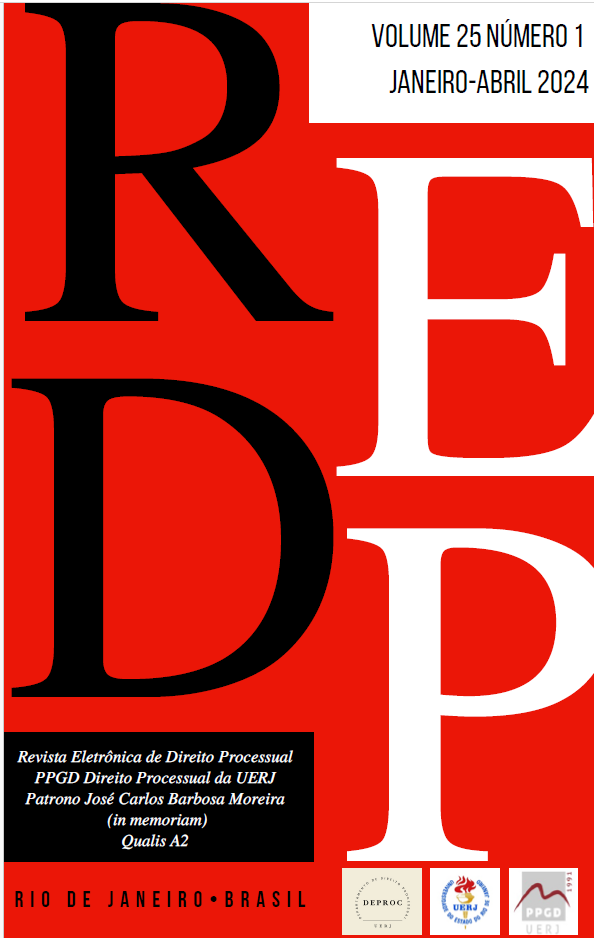A FUNÇÃO DO AMICUS CURIAE COMO MECANISMO DE ACESSO À JUSTIÇA NAS DEMANDAS JUDICIAIS ENVOLVENDO NOVAS TECNOLOGIAS
DOI:
https://doi.org/10.12957/redp.2024.81888Resumo
As Tecnologias de Informação e Comunicação (TICs) têm desencadeado uma rápida transformação na sociedade, impactando profundamente todas as esferas da vida humana, inclusive o campo do Direito. Este último, sendo uma ciência social em constante evolução, busca se adaptar às mudanças sociais para assegurar a justiça e a equidade. Contudo, a velocidade e a complexidade das mudanças trazidas pelas novas TICs representam um desafio significativo para o Direito, já que a legislação muitas vezes não acompanha tão prontamente essas transformações. A dinâmica acelerada das novas tecnologias gera uma série de conflitos legais que chegam diariamente aos tribunais. No entanto, nem sempre os juízes possuem o conhecimento técnico necessário para compreender os intricados detalhes dos novos temas apresentados, o que se torna um entrave ao acesso à justiça. Diante dessa realidade, a pesquisa teve como objetivo investigar a viabilidade da intervenção do amicus curiae em demandas judiciais que envolvem novas tecnologias. A análise foi desenvolvida em um nível exploratório e explicativo, adotando o método dedutivo. Para embasar o estudo, foram examinadas a literatura especializada e a legislação pertinente ao tema, utilizando técnicas de pesquisa bibliográfica e documental. A pesquisa demonstrou que o amicus curiae pode ser um instrumento eficaz para garantir o acesso à justiça frente às demandas judiciais envolvendo novas tecnologias. O amicus curiae permite que a sociedade civil contribua para o processo judicial, fornecendo informações e esclarecimentos que são relevantes sobre os fatos e as questões jurídicas envolvidas no caso, facilitando a apreensão do Direito frente às novas TICs e, principalmente, auxiliando o magistrado na compreensão dos temas complexos e específicos que surgem nesse contexto. A presença do amicus curiae em ações judiciais complexas e carregadas de particularidades – como é caso das demandas quem envolvem novas tecnologias – favorecem à correta apreciação do litígio e melhor aplicação da norma e o aprimoramento da tutela jurisdicional.
Downloads
Publicado
Como Citar
Edição
Seção
Licença
Copyright (c) 2024 Diego Bianchi de Oliveira, Rogério Mollica

Este trabalho está licenciado sob uma licença Creative Commons Attribution 4.0 International License.
Todos os artigos publicados na Revista Eletrônica de Direito Processual (REDP) (Departamento de Direito Processual, Universidade do Estado do Rio de Janeiro, Brasil) são licenciados por meio de uma Licença Creative Commons - Atribuição 4.0 Internacional (CC BY 4.0).
Os autores retêm os direitos autorais de seu artigo e concordam em licenciar seu trabalho com a licença CC BY 4.0, aceitando assim os termos e condições específicos desta licença disponíveis no seguinte website: https://creativecommons.org/licenses/by/4.0/legalcode.
- Os autores concedem à REDP o direito de primeira publicação, de se identificar como publicadora original do trabalho e concedem à revista uma licença de direitos não exclusivos para utilizar o trabalho das seguintes formas: Reproduzir, vender e distribuir cópias eletrônicas ou impressas do manuscrito como um todo, de partes específicas do manuscrito e de suas traduções para qualquer idioma;
- O uso do artigo por terceiros é livre, contanto que a integridade da publicação seja mantida e seus autores originais, periódico de primeira publicação e detalhes de citação sejam identificados.
Dentro dos termos da licença, os autores podem entrar em acordos contratuais adicionais separados para a distribuição não exclusiva da versão publicada do trabalho na revista.
Copyright and Licensing
All articles published in the Procedural Law Electronic Review (REDP) (Department of Procedural Law, State University of Rio de Janeiro, Brazil) are licensed under a Creative Commons License - Attribution 4.0 International (CC BY 4.0).
- Authors retain copyright to their article and agree to license their work under the CC BY 4.0 license, thereby accepting the specific terms and conditions of this license available at the following website: https://creativecommons.org/licenses/by/4.0/ legal code.
- Authors grant REDP the right of first publication, to identify itself as the original publisher of the work, and grant the journal a non-exclusive license to use the work in the following ways: Reproduce, sell and distribute electronic or printed copies of the manuscript as a whole, of specific parts of the manuscript and its translations into any language;
- Use of the article by third parties is free, as long as the integrity of the publication is maintained and its original authors, first publication journal, and citation details are identified.
Within the terms of the license, authors may enter into separate additional contractual agreements for the non-exclusive distribution of the published version of the work in the journal.




